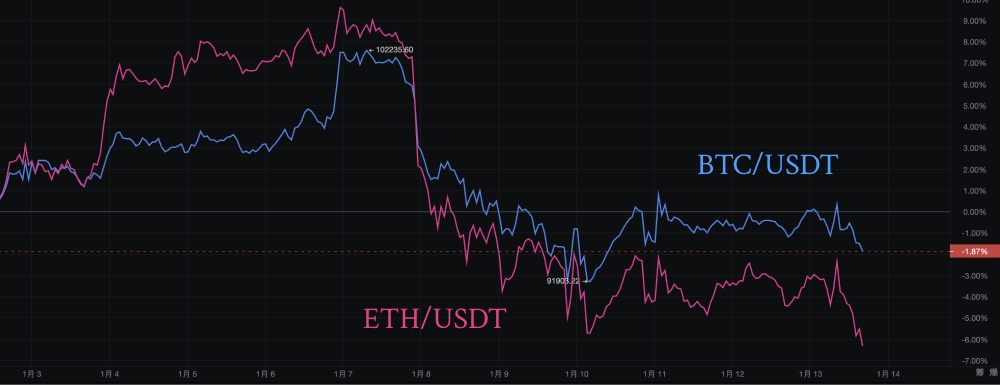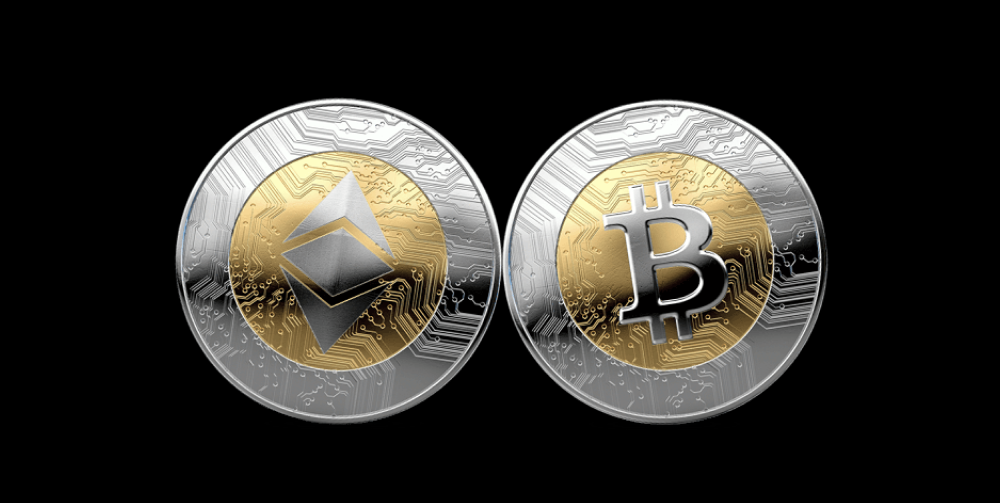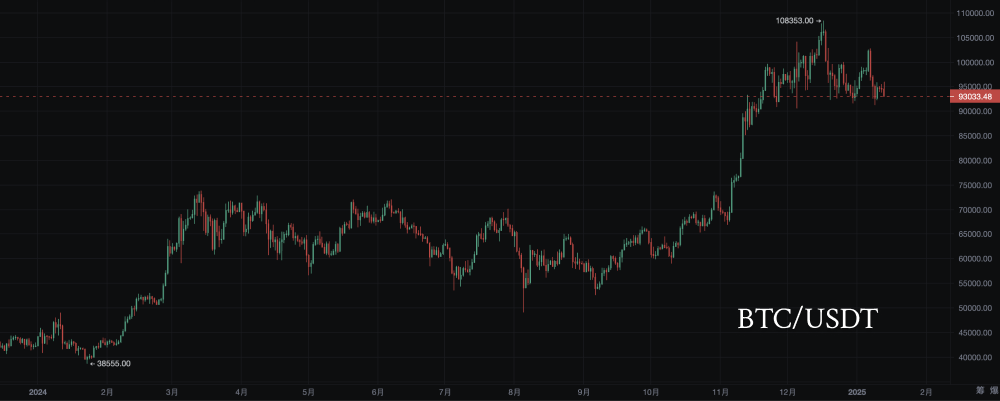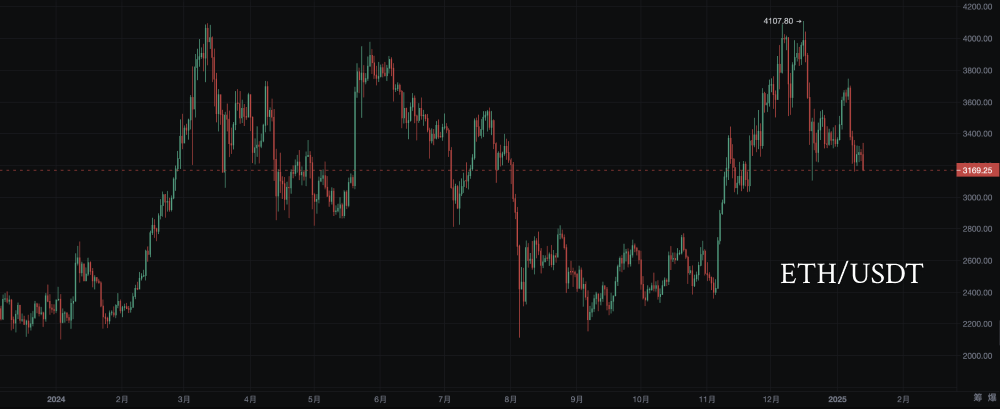Significant Similarities in the Price Trends of Bitcoin (BTC) and Ethereum (ETH)
In the cryptocurrency market, Bitcoin (BTC) and Ethereum (ETH), as the top two assets by market capitalization, exhibit a high degree of correlation in their price movements, a phenomenon particularly evident during market fluctuations. From the chart data you provided, it can be observed that the trends of both assets show significant synchronization in terms of timing, trend direction, and volatility characteristics.
1. Characteristics of Synchronized Trends
By observing the trends of BTC (pink line) and ETH (blue line), the following patterns can be identified:
- Co-directional fluctuations: Whether it is a rapid rise or fall in the short term, BTC and ETH maintain consistency in the direction of price changes. For example, both experienced a significant drop on January 8, followed by a synchronized rebound on January 10.
- Synchronization of price peaks and troughs: The peaks and troughs of both assets almost occur at the same time points, indicating that market drivers affect these two assets synchronously.
- Differences in volatility magnitude: Although the trends are similar, the volatility of ETH is often greater than that of BTC. This can be attributed to Ethereum's relatively smaller market capitalization, making its price more sensitive to capital flows.

2. Historical Correlation
The price correlation between BTC and ETH can be validated through statistical models. According to historical market data, the daily return correlation coefficient between BTC and ETH typically reaches 0.85~0.95, demonstrating a significant linear positive correlation. This strong correlation is evident not only in short-term fluctuations but also in long-term trends.
Deep Reasons for the Similarity in Price Trends of Bitcoin and Ethereum
1. Unity of Market Sentiment
Market sentiment is the core driving force behind the similarity in BTC and ETH trends. As "barometers" of the cryptocurrency market, both hold a highly similar position in investor psychological expectations:
- Resonance of fear and greed: When market greed drives BTC prices up, ETH, as a secondary core asset, usually attracts capital; conversely, when market fear dominates, BTC and ETH often experience synchronized pullbacks.
- Consistency in institutional investor behavior: As the proportion of institutional investors in the crypto market increases, their asset allocation behavior tends to unify. For example, funds often allocate to both BTC and ETH simultaneously, leading to linked capital flows.
2. Resonance of Macroeconomic Factors
Both BTC and ETH, as cryptocurrency assets, are jointly influenced by global macroeconomic factors:
- Impact of monetary policy: For instance, adjustments in the Federal Reserve's interest rate policy directly affect the attractiveness of risk assets, leading to synchronized fluctuations in BTC and ETH.
- Geopolitical risks: Uncertainties in global financial markets (such as wars, sanctions, etc.) can trigger changes in demand for safe-haven assets, similarly affecting the prices of BTC and ETH.
3. Interconnectivity of Market Structure
The high correlation between BTC and ETH is also closely related to the structural characteristics of the cryptocurrency market:
- Trading pair linkage effect: The BTC/ETH trading pair is one of the most liquid trading pairs in the market. When capital flows into or out of BTC or ETH, the price mechanism of this trading pair quickly balances, leading to similar price changes for both.
- Impact of the derivatives market: The futures and options markets for BTC and ETH have high trading volumes and open interest, and large capital positions or liquidations can simultaneously affect the spot prices of both.
4. Capital Flow and Portfolio Effects
The cryptocurrency market has high liquidity, and BTC and ETH, as mainstream assets, attract the majority of capital inflows:
- Index funds and passive investment: Many cryptocurrency index funds consider BTC and ETH as core allocation assets, further enhancing the synchronization of their price trends.
- Arbitrage trading and strategy trading: Quantitative traders often use cross-asset arbitrage strategies to keep the price difference between BTC and ETH within a reasonable range, thereby strengthening price linkage.
5. Convergence of Narrative Logic
BTC and ETH each have their positioning in the market: BTC is viewed as "digital gold," primarily for value storage; ETH, as the "king of smart contract platforms," provides rich ecosystem support. However, in the overall market narrative, both are classified as core assets of blockchain technology and decentralization, leading to highly similar responses in their prices to changes in macro narratives.

III. Professional Analysis Based on Market Theory
1. Efficient Market Hypothesis (EMH)
The Efficient Market Hypothesis posits that market prices reflect all publicly available information. The synchronization of BTC and ETH prices can be interpreted as the market's efficient response to the same information. For example, when the Federal Reserve releases dovish signals, the market anticipates increased capital inflows into risk assets, and this information is quickly reflected in the prices of BTC and ETH.
2. Behavioral Finance and Herding Effect
According to behavioral finance theory, investors often exhibit a "herding effect," where investment decisions are influenced by the actions of others:
- BTC as a market indicator: Bitcoin serves as a "barometer" for the cryptocurrency market, with its price fluctuations often leading market sentiment, while Ethereum and other assets follow suit.
- Emotion transmission mechanism: When BTC prices rise rapidly, investors tend to interpret this signal as an increase in market risk appetite, further driving up ETH prices.
3. Supply and Demand Model and Price Mechanism
The supply and demand relationships of BTC and ETH are driven by mining economics and network effects:
- Supply side: BTC's supply is constrained by block reward halving, while ETH has entered a deflationary model since its upgrade to Ethereum 2.0, enhancing the attractiveness of both as assets due to their scarcity.
- Demand side: Demand for capital in the cryptocurrency market typically concentrates on leading assets (BTC and ETH), maintaining synchronized price drivers.
4. Capital Asset Pricing Model (CAPM) Perspective
According to CAPM theory, the high correlation between BTC and ETH can be explained by both facing similar systematic risks. For instance, changes in the macroeconomy affecting the overall market risk premium will simultaneously impact both BTC and ETH.
IV. Recent Trend Professional Interpretation and Outlook
1. Recent Trend Review
- Early January surge: In early January, BTC and ETH both experienced significant increases, likely benefiting from market expectations of the Federal Reserve pausing interest rate hikes and rising investor demand for risk assets.
- Rapid decline on January 8: Both assets saw synchronized pullbacks on January 8, primarily due to short-term profit-taking and market concerns over macro data.
- Rebound on January 10: Subsequently, market sentiment slightly recovered, pushing BTC and ETH back up, indicating that the market has not yet entered a prolonged bear phase.
2. Future Trend Outlook
Based on market theory and recent data, the following analysis can be made regarding the trends of BTC and ETH:
- Macroeconomic drivers: The future trends of BTC and ETH will continue to be influenced by Federal Reserve policies, the movement of the dollar index, and global economic data. For example, if the Federal Reserve further releases dovish signals, both may strengthen simultaneously.
- Technical drivers: Further expansion of the Ethereum ecosystem (such as the growth of Layer 2) may enhance ETH's fundamental value, while Bitcoin's institutional trend (such as spot ETF approvals) will continue to attract long-term capital.
- Short-term volatility prediction: In the short term, BTC and ETH may maintain high correlation, but caution is needed regarding the risks of high-leverage liquidations triggered by sharp market sentiment fluctuations.
Annual Review Analysis of Bitcoin and Ethereum Trends
1. Overall Trend Analysis
- Early year rebound: At the beginning of 2024, both BTC and ETH saw significant rebounds. BTC surged from $40,000 to $65,000, while ETH climbed from $1,200 to nearly $2,000. This was primarily due to improvements in the global economic situation, reduced expectations of Federal Reserve interest rate hikes, and a rebound in market risk appetite.
- Mid-year consolidation: Both entered a consolidation phase in mid-2024, with BTC prices fluctuating between $65,000 and $75,000, while ETH oscillated between $2,400 and $2,900. Market sentiment during this phase tended to be cautious, with trading volumes declining.
- Year-end surge: In the fourth quarter of 2024, BTC and ETH broke through their previous consolidation ranges. BTC surpassed the $90,000 mark, while ETH rose above $3,800. This phase benefited from a shift towards accommodative macro policies and market enthusiasm driven by blockchain technology innovations.


2. Changes in Trading Volume
When the Federal Reserve paused interest rate hikes, trading volumes for both assets significantly increased, indicating a heightened preference for risk assets among investors. Geopolitical events (such as the easing of the Russia-Ukraine situation) also led to global capital inflows into the cryptocurrency market, further boosting trading volumes.
3. Linked Reactions to Macroeconomic Events
- Federal Reserve policies: BTC and ETH respond synchronously to interest rate decisions and inflation data. Accommodative monetary policies release liquidity, driving up the prices of both.
- Dollar index fluctuations: During the dollar's weakening in 2024, BTC and ETH attracted more safe-haven capital inflows as non-sovereign assets.
- Geopolitical situation: After global risks eased, investor confidence was boosted, leading to synchronized increases in BTC and ETH.
4. Differences in Volatility Characteristics
(1) Volatility Magnitude
- BTC: As digital gold, BTC's price volatility is relatively small. The maximum drawdown for the entire year of 2024 was about 15%, reflecting its safe-haven attributes.
- ETH: The volatility is greater, with the maximum drawdown during the year approaching 30%, and its gains are also more significant, indicating that ETH's market sentiment is more sensitive.
(2) Differences in Driving Factors
- BTC driving factors: Mainly determined by the macroeconomic background, institutional capital inflows, and overall market sentiment.
- ETH driving factors: More influenced by ecological fundamentals, including the activity of decentralized finance (DeFi), non-fungible token (NFT) trading, and technological innovations (such as Layer 2 scaling).
(3) Market Performance
- BTC's annual increase was approximately 250%, rising from $45,000 to nearly $100,000.
- ETH's annual increase was approximately 180%, rising from $1,200 to $3,800.
5. Differences in Investor Structure
(1) BTC Investors
- Institution-led: BTC attracts large institutional investors such as Grayscale Trust and MicroStrategy due to its stability and scarcity.
- Low-risk preference: BTC's safe-haven attributes make it more suitable for long-term stable capital allocation.
(2) ETH Investors
- Retail and developer-led: The ETH ecosystem attracts a large number of developers, DeFi project teams, and retail investors.
- High-risk preference: The high volatility and wide application scenarios of ETH make it the preferred choice for high-risk, high-reward investors.
If you have any questions, you can contact us through the following official channels:
AICoin official website: www.aicoin.com
Telegram: t.me/aicoincn
Twitter: x.com/AICoincom
Email: support@aicoin.com
Group chat: Customer Service Yingying、Customer Service KK
免责声明:本文章仅代表作者个人观点,不代表本平台的立场和观点。本文章仅供信息分享,不构成对任何人的任何投资建议。用户与作者之间的任何争议,与本平台无关。如网页中刊载的文章或图片涉及侵权,请提供相关的权利证明和身份证明发送邮件到support@aicoin.com,本平台相关工作人员将会进行核查。



